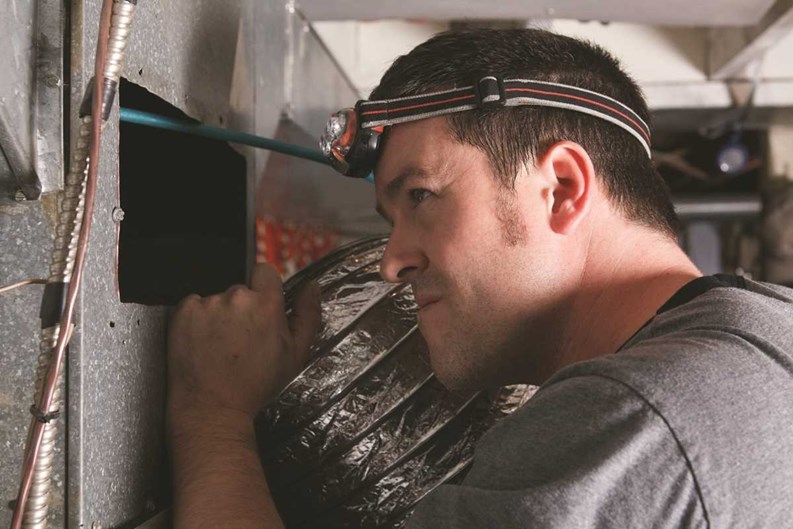During the winter season, life isn’t exactly a walk in the park for your typical New York City building. Freezing rain and wind beat at the façade relentlessly; snow accumulates on the roof and turns to ice, then thaws and seeps into co-op or condo units below, and most systems work double time to keep home-bound residents warm and cozy.
With the first days of spring at hand, it’s time to take stock of any damage the winter has done. No doubt, the moment has come to launch a spring cleaning and repair program.
It’s What’s Outside that Counts
Best to complete in early March, a spring season inspection works from the outside in. Typically, the first order of business is a comprehensive evaluation of the exterior envelope.
“More important than anything, we want to make sure there's nothing hanging off the building,” says Wayne Bellet, owner of Bellet Construction, a 96-year-old exterior maintenance and restoration company based in Manhattan. “If anything becomes displaced or loosened by the wind, we want to take care of it immediately.”
Next, examine the building envelope for signs of damage that might allow water to penetrate the facade. “In the winter, freezing temperatures will cause metal and brick elements to expand,” says Jeff Heidings, the president of Siren Management, a Manhattan-based management company. “When they thaw in the spring, you can see the cracks, the gaps and the openings that can result in water penetration.”
Areas where two types of materials intersect cause particular concern, for example, limestone, brick, or concrete and metal. “When two dissimilar materials meet, they have different properties and differing reactions to the elements,” explains Bellet. “Masonry moves differently than metal moves. Sometimes, you will have cracking because the concrete is not as strong as the metal it is sitting in.”
In regard to inspecting the façade, Bellet offers further advice. “You don't have to be a rocket scientist to see that something is not right,” he says. “Look for gaps, cracks, fissures, blisters, buckles, flaking—anything that would be deemed defective. If moisture gets in—no matter how much moisture—it causes expansion and contraction,” which can seep into co-op or condo units through walls and around window sills.
Little Crack…Big Flood
“We had one crack in the wall on the 22nd floor that caused a flood in the kitchen when it rained, and then went down to the 21st floor,” recalls Enes Radoncic, a superintendent at a 325-unit co-op on the Upper West Side. “It was an incredibly small crack but the rain was so intense that water came into two apartments.” Not surprisingly, the resulting repair was a big expense.
Minor cracks in the façade can be treated with silicone, a simple—albeit temporary—solution. In older buildings, however (as most are in New York City) aging bricks might require replacing.
To gauge the extent of required repair on a particular crack or fissure in the façade or on the roof, “I want to see a photograph,” says Bellet. He advises supers to keep “an ongoing, fastidious, obsessive photo journal that they constantly update. I look for any abrupt change. I compare it to the last series of photos to establish the severity of what needs to be done.”
To access damage to the façade that might not register on a visual inspection, reach out to the residents, suggests Heidings. “Some diligent managers have their supers go around the building or send out a questionnaire to people after the winter, asking if they see any signs of water penetration in their apartments.”
Up on the Rooftop
The next stop is the rooftop. “Low temperatures in the winter can cause cracks in the roofing cement if you are not careful about patching cracks the rest of the year,” says Radoncic. The main culprit is snow, which can pile high and then melt slowly when temperatures increase. “Water seeps under the concrete,” he explains, “and leaks into the apartment ceilings.”
With a single blister or crack on the roof covering, the solution is simple and cheap, says Bellet: cut it out, dry the area, and patch it. “But if you call me in three, six, or eight months and have two more blisters, you've got to take the gun out and shoot the horse.” That is…it’s time to replace the roof.
While you’re up on the roof, Heidings provides additional advice. “Check the parapet walls and coping stones, and the joints of the coping stones to see if there are any expansion or contraction cracks,” he explains. Parapet walls are expensive to repair, and should be monitored and maintained regularly throughout the year.
He adds a little more insight into the topic. “The spring is a good time to make sure all your drains are clear of debris,” says Heidings. Additionally, check the water tank closely for any signs of damage. “If you had a harsh wind perhaps the cover moved or cracked, a lot of things can happen.”
The fire escape—another important exterior element—should be surveyed, as well. A rusty fire escape violates the New York City building codes and can make for a costly citation.
“As long as there is no lead in the paint, that’s something the staff can do themselves,” says Bellet. “The fire escape is easily reached; you can get out there and scrape it down, re-prime, and paint. People are constantly asking me to do that, and I always wonder why the staff doesn't take care of it themselves.”
Despite a few misconceptions, one job is not part of the spring exterior maintenance routine, according to Heidings. “Cleaning the façade is a very expensive proposition done with scaffolds, sidewalk sheds and power-washing the brick. It's done every 50 years. It’s not part of spring cleaning.”
Hit the Pavement
Co-op shareholders and condo association members in New York City have the dubious privilege of owning (and the responsibility for maintaining) the sidewalk in front of their buildings. Defective sidewalks are subject to violations issued by the city’s Department of Transportation (DOT). If cracks cause someone to trip and fall, of course, they can result in a major lawsuit.
Cracks in the sidewalk—a common result of the expansion and contraction caused by the winter freeze/thaw cycle and erosion of the connecting joints in reaction to the salt applied over snow and ice—allow water to leak into the building infrastructure, possibly flooding the storage, boiler room, laundry, or other basement areas.
Minor cracks in the pavement and joints connecting the concrete can be filled with silicone, but an elevation of half-an-inch or more is a tripping hazard and might require replacing the entire concrete slab.
On the Inside
Normally, building staff cleans interiors throughout the year, but they need to step up the routine in winter and early spring to deal with extra dirt and debris dragged in from the street.
“While every good superintendent always monitors the basement areas, in a particularly harsh winter with the boiler running constantly, they might want to do an extra cleaning of the boiler tubes and other maintenance work to maintain efficiency and economy,” says Heidings.
Also in spring, the pumps command special attention, specifically the ones that take water from areas of the building to the city drains during a flood. They should be tested, and debris removed.
Clear the Air
Winter is the season for hunkering down, staying warm and cozy at home. With windows closed, A/C units sealed off, we cook at home or order out, watch TV, read a book—bide time through the long, cold, dark winter nights until spring has sprung.
Three or four months with the windows closed and co-op and condo units at maximum occupation, as the environmental professionals call it, leaves a toll on ventilation and exhaust systems in the building.
According to Ryan Schneider, managing director of sales at Chute Master Environmental based in Union, New Jersey, “With greater occupation during the winter a number of contaminants and air pollutants, specifically pet dander, dust or even chemicals, are pulled into the HVAC system and re-circulated up to five and seven times a day.”
Even buildings without elaborate HVAC systems recycle contaminants through bathroom and kitchen exhaust vents and ducts. With windows closed, explains Schneider, “all the heat and condensation and buildup in the air in the bathroom goes to the path of least resistance: the exhaust vent.”
The building should call in an environmental cleaning professional in the spring to access the health of the ventilation duct work throughout the building and, if necessary, clean the ducts to remove the buildup of contaminants. The professionals use powerful EPA-approved HEPA vacuums to suck up and dispose of fine particles. If clogged, the ducts can release contaminated air into the living spaces. And clogged ducts put stress on the building’s mechanical exhaust systems.
What Goes Down
During the winter, everyone suddenly discovers how close they are to the trash room.
“During the holidays people throw anything and everything down the trash chute, and in winter people order food in more,” says Schneider—“and not everybody packages their garbage the way they should.”
The contents of leaking trash bags and open bottles and containers stick to the trash chutes and accumulate in the basement trash compactor, causing a buildup of odor and organic debris, which can attract pests. Items such as unopened paint cans can cause a fire hazard.
“When you don't clean the mechanical properties of the trash chute, it tends to break, pumps tend to go, hoses tend to go, and you end up paying for costly repairs and replacing your compactor years earlier than you should,” says Schneider.
According to Bob Frustaci of Premier Compaction Systems, based in Woodland Park, New Jersey, a spring checkup and maintenance call includes, “inspecting every trash door and baffles on every floor, and making sure they operate correctly. With the compactor, we will do preventative maintenance: check the switches, the relays, crack or welds, the oil, the fire suppressant and the equipment that surrounds it. We make sure it is operating to full capacity. We check that there are no hydraulic leaks or wear and tear on metal.”
As with most mechanical systems in the building, adds Frustaci, “if we catch it early enough, you can save thousands.”
Community Clean-Up Day!
Spring is the perfect time to have a community clean-up day, where residents take a hand in minor exterior maintenance and cleaning tasks like painting railings and clearing trash and debris, all the while enjoying a spirit of camaraderie. Isn’t it?
“Frankly, no,” says Heidings. “Never to my knowledge in New York do residents do anything like that. These are staff maintenance items.”
It’s primarily a liability issue. “What if somebody's doing something around the building and they get hurt?” posits Heidings. “In co-ops and condos, you do have maintenance committees or house committees from time to time where a couple of people just keep an eye on the house and point things out to management and the board.” And then management gives direction to the staff, he says.
Leaving spring cleaning to the professionals will make maintenance during the summer and fall a breeze.
Steven Cutler is a freelance writer and a frequent contributor to The Cooperator.










Leave a Comment